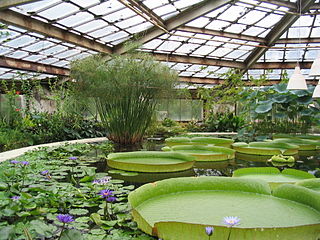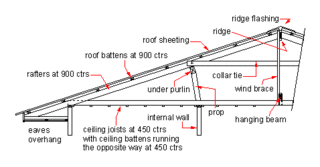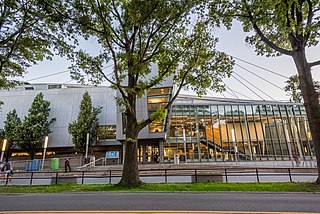This article needs additional citations for verification .(April 2010) (Learn how and when to remove this template message) |

Tessellated roof is a frame and a self-supporting structural system in architecture. A simple ridged roof may inside be a tessellated system. The interlinking shapes are replicated across the moulded surface using curvilinear coordinates, a specific technique with rigid interlinking beams, having characteristics similar to woven fabric. A tessellated roof is one of the most flexible framed systems to design. The measurements and precision are complex and commonly part of a computer-aided design process of production. It is used in a honeycomb geometry form, in the biomes of the Eden Project.

Framing, in construction, is the fitting together of pieces to give a structure support and shape. Framing materials are usually wood, engineered wood, or structural steel. The alternative to framed construction is generally called mass wall construction, where horizontal layers of stacked materials such as log building, masonry, rammed earth, adobe, etc. are used without framing.
The term structural system or structural frame in structural engineering refers to the load-resisting sub-system of a building or object. The structural system transfers loads through interconnected elements or members.

Architecture is both the process and the product of planning, designing, and constructing buildings or any other structures. Architectural works, in the material form of buildings, are often perceived as cultural symbols and as works of art. Historical civilizations are often identified with their surviving architectural achievements.
It can be fabricated to fit a wide range of situations. The size of the repeated geometric shape used can be customised, with a multitude of the same shape throughout the structure. An even and equal load is shared by the interlocking structural integrity of the frame as a whole. The use of a tessellated roof for public areas is an increasingly implemented architectural feature of modern public buildings, covering walkways and over retail centers. A transparent roof being for shelter from the weather, has an advantage during daylight with electricity for artificial lighting in solid roof buildings being a financial cost.

A public space is a place that is generally open and accessible to people. Roads, public squares, parks and beaches are typically considered public space. To a limited extent, government buildings which are open to the public, such as public libraries are public spaces, although they tend to have restricted areas and greater limits upon use. Although not considered public space, privately owned buildings or property visible from sidewalks and public thoroughfares may affect the public visual landscape, for example, by outdoor advertising. Recently, the concept of Shared space has been advanced to enhance the experience of pedestrians in public space jointly used by automobiles and other vehicles.

In American English, walkway is a composite or umbrella term for all engineered surfaces or structures which support the use of trails.

A shopping mall is a modern, chiefly North American, term for a form of shopping precinct or shopping center, in which one or more buildings form a complex of shops representing merchandisers with interconnecting walkways that enable customers to walk from unit to unit. A shopping arcade is a specific type of shopping precinct which is usually distinguished in English for mall shopping by the fact that connecting walkways are not owned by a single proprietor and are in open air. Shopping malls in 2017 accounted for 8% of retailing space in the United States.
A modern tessellated roof for roofing public areas is a variation of a greenhouse or glass roof in different shapes and sized. The roof can be held aloft with columns, that may have branches to support and connect to the roof latticework, which stabilise the roof to create a strong structure. The material of the roof in-between or covering the tessellated frame may be a light composite, toughened glass or insulated glazing. There are roofed boulevards with columns that can form a colonnade. Some tessellated roof shapes connect to the ground in place of conventional rain gutters, for example the FieraMilano, or it can be supported entirely by the surrounding buildings. A tessellated roof can convert previous outdoor space into a dry public area; some examples of this method are Galleria Vittorio Emanuele II and many other shopping complexes or the Queen Elizabeth II Great Court at the British Museum in London by Norman Foster.

A greenhouse is a structure with walls and roof made chiefly of transparent material, such as glass, in which plants requiring regulated climatic conditions are grown. These structures range in size from small sheds to industrial-sized buildings. A miniature greenhouse is known as a cold frame. The interior of a greenhouse exposed to sunlight becomes significantly warmer than the external ambient temperature, protecting its contents in cold weather.

A column or pillar in architecture and structural engineering is a structural element that transmits, through compression, the weight of the structure above to other structural elements below. In other words, a column is a compression member. The term column applies especially to a large round support with a capital and a base or pedestal which is made of stone, or appearing to be so. A small wooden or metal support is typically called a post, and supports with a rectangular or other non-round section are usually called piers. For the purpose of wind or earthquake engineering, columns may be designed to resist lateral forces. Other compression members are often termed "columns" because of the similar stress conditions. Columns are frequently used to support beams or arches on which the upper parts of walls or ceilings rest. In architecture, "column" refers to such a structural element that also has certain proportional and decorative features. A column might also be a decorative element not needed for structural purposes; many columns are "engaged", that is to say form part of a wall.

A composite material is a material made from two or more constituent materials with significantly different physical or chemical properties that, when combined, produce a material with characteristics different from the individual components. The individual components remain separate and distinct within the finished structure, differentiating composites from mixtures and solid solutions.




















